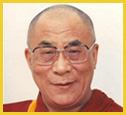| The most distinctive
feature of this Medicine Buddha is his color, the deep blue of lapis lazuli. This
precious stone has been greatly prized by Asian and European cultures for more
than six thousand years and, until relatively recently, its ornamental value was
on a par with, or even exceeded, that of the diamond. An aura of mystery surrounds
this gemstone, perhaps because of its principal mines are located in the remote
Badakshan region of northeast Afghanistan, an all-but-inaccessible area located
behind the Hindu Kush. One commentator has written, "the finest specimens
of lapis, intensely blue with speckled waves and swirls of shining gold-colored
pyrite, resemble the night aglow with myriads of stars." Traditionally this
beautiful stone was used to symbolize that which is pure or rare. It is said to
have a curative or strengthening effect on those who wear it, and its natural
smoothness allows it to be polished to a high degree of reflectivity. For all
these reasons plus the fact that deep blue light has a demonstrable healing
effect on those who use it in visualization practices lapis is the color
of the principal Medicine Buddha. The Lapis Healing Master is one of the
most honored figures in the Buddhist pantheon. The sutras in which he appears
compare his eastern pure land with the western paradise of Amitabha, and rebirth
there is said to be as conducive to enlightenment as is rebirth in Sukhavati.
Recitation of his mantra, or even the mere repetition of his holy name, is said
to be sufficient to grant release from the lower realms, protection from worldly
dangers and freedom from untimely death. In one of the main sutras concerning
the Medicine Buddha, Shakyamuni tells his close disciple and attendant Ananda: If
these sentient beings [those plunged into the depths of samsara�s sufferings hear
the name of the Lord Master of Healing, the Lapis Lazuli Radiance Tathagatha,
and with utmost sincerity accept it and hold onto it, and no doubts arise, then
they will not fall into a woesome path. In Tibet the Medicine
Buddha is revered as the source of the healing arts for it is through him that
the teachings embodied in the Four Medical Tantras, the basis of Tibetan medicine,
came into being. As explained in the first of these Four Tantras, the Lapis Lazuli
Healing Master was once seated in meditation surrounded by an assembly of four
circles of disciples including divine physicians, great sages, non-Buddhist gods
and bodhisattvas, all of whom wished to learn the art of healing. Rendered speechless
by the radiant glory of his countenance, they were unable to request the desired
teachings. To accommodate their unspoken wishes, the Medicine Buddha manifested
two emanations, one to request the teachings and the other to deliver them. In
this way, then, the Buddhist explanation of the various mental and physical ailments,
their causes, diagnoses and treatment and the maintenance of health is said to
have originated. According to the Four Tantras, the fundamental cause
of every disease is to be found in the three poisonous delusions ignorant
bewilderment, attachment and hatred occupying the hub of the wheel of samsaric
existence. These three root delusions lead to imbalances in three so-called humors
(phlegm, wind and bile), the various bodily constituents (blood, flesh, bone,
etc.) and waste products, or impurities (excrement, urine and perspiration), all
of which are analyzed in twenty-five divisions. The Root Tantra says: Thus
if all these twenty-five are in balance and the three factors of the (1) tastes
and (2) inherent qualities of one�s food and (3) one�s behavior are wholesome,
one�s health and life will flourish. If they are not, one�s health and life will
be harmed. And further on: Attachment, hatred and bewilderment
are the three causes producing imbalances of wind, bile and phlegm. Along with
these, the four contributing circumstances of time, spirits, food and behavior
cause the humors to increase and decrease. The imbalance then spreads over the
skin, increases in the flesh, moves along the vessels, meets the bones and descends
upon the solid and hollow organs. Treatment of disease
and the maintenance of health are therefore primarily a matter of bringing the
various elements of the body back into balance and this is accomplished through
four progressive types of treatment. The first two involve changes in the type
of food we eat and behavior we engage in. Only when these prove ineffective is
the physician advised to prescribe medicine and only when this also fails is he
or she to resort to external forms of treatment such as cauterization and the
like. However, none of these types of treatment will have a lasting effect unless
they are accompanied by spiritual transformation. If ignorance and its associated
delusions remain festering inside, sooner or later they will give rise to disease
and the recurring miseries of cyclic existence. Thus Buddhas such as Shakyamuni
and the Lapis Healing Master are referred to as great physicians not because of
their medical abilities as great as these are but because they have
the compassion, wisdom and skillful means to diagnose and treat the root delusions
underlying all mental and physical malaise. The following
prayer of request is addressed to the Lapis Healing Master: I beseech you, Blessed
Medicine Guru,
Whose sky-colored, holy body of lapis lazuli
Signifies
omniscient wisdom and compassion
As vast as limitless space,
Please grant
me your blessings.
I beseech you, Blessed Medicine Guru,
Holding
in your right hand the king of medicines
Symbolizing your vow to help all
the pitiful sentient beings
Plagued by the four hundred and twenty-four diseases,
Please grant me your blessings.
I beseech you, Blessed Medicine Guru,
Holding in your left hand a bowl of nectar
Symbolizing your vow to give the
glorious undying nectar of the dharma
Which eliminates the degenerations of
sickness, old age and death,
Please grant me your blessings. |

